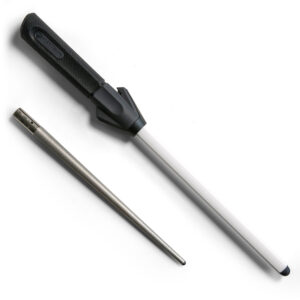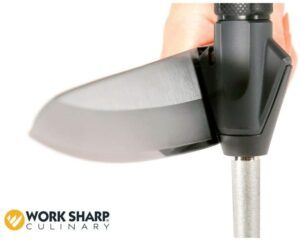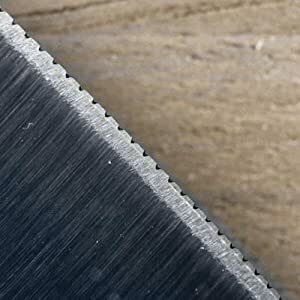
I’m Definitely Digging The Creativity/Innovation!
Welcome back to yet another Work Sharp knife sharpener review! Last time we looked at the Work Sharp E2: a kitchen knife sharpener that’s reasonably priced, versatile in that in can sharpen scissors as well, and pretty effective when it’s all said and done. If you wanna know more about the E2, be sure to check out the full review here!
Today’s review is about the Work Sharp Culinary M3: at first glance one may mistake it for a honing steel, but it’s very much a sharpener!

Before we get into the details of this thing, I must tell you I really like the creativity behind the M3. Work Sharp have taken the concept/design of the honing steel and transformed that into a full blown sharpener with interchangeable rods. Brilliant!
This is very much a manual (non-electric) sharpener, so you do get a ton of sharpening control (not something you get with electric sharpeners).
While there’s a lot to like about this manual sharpener, there are a few things right off the bat that I do not like. For example, the built in angle guides are fixed at 17 degrees. This is a downfall if I have a 20 degree edge and don’t wish to “thin” it down to 17 degrees.
Work Sharp Culinary M3 Knife Sharpener: 4 Interesting Features!
#1 Interchangeable Abrasive Rods!
The Work Sharp M3 is designed such that the rods can be removed and interchanged. When you buy the M3, you get 2 rods:
I really love how the rods are interchangeable, but I think Work Sharp could’ve taken this a step further by making additional rods available for purchase. For example, if you wanted a really fine grit (to put a mirror edge), like a 6000-8000, then this is something you could purchase.
Based on my research (and knowledge), the only 2 rods that are available for the M3 are the 2 that it comes with, and that’s too bad because having additional rods would make the M3 way more powerful!

#2 It’s Incredibly Easy To Use!
If you’re looking for a sharpener that’s easy to use, then you won’t find much easier than the M3. The fact that it has built in angle guides means the guesswork in trying to figure out angles is pretty much eliminated.
Angle guides are a good thing, but they are also a bad thing. Why?
Well they’re a good thing because they eliminate guesswork by telling the user exactly how to position the knife edge. Angle guides a bad thing because they introduce angle restrictions which means users lose out on the flexibility of being able to sharpen at different angles.
For example, if I have 2 knives, one that has a 17 degree edge and the other a 15 degree edge, I won’t have issues with the 17 degree edge, but I will have issues using the M3 to sharpen my 15 degree edge, as the built in angle guides are set at 17 degrees.

Hopefully this all makes sense to you. Of course these won’t be issues for those who don’t own a collection of kitchen knives that all have different edge angles!
Going back to the original point, the M3 is very easy to use. All it takes is a bit of attention and a steady hand!
#3 MicroForge Technology
This one is interesting and I’m not sure if I quite like it. MicroForge is a technology or a process in which tiny microscopic notches are formed on a knife’s edge. It’s hard to explain with words, so check out the picture below and you’ll understand what I’m talking about!

Work Sharp claims that this technology allows for an edge to retain its cutting ability for longer, so you don’t have to sharpen as often.
How do you apply MicroForge?
There is a MicroForge port located on the handle area of the M3. The idea is that you do a couple passes on each side of the edge, and the end result is what you see in the image above! To remove the MicroForge, you simply resharpen the edge as you normally would.
Should you MicroForge your knives?
I have not tried it so I can’t speak to how effective of a technology it is, but from personal experience sharpening knives, I would be a tad hesitant to mess around with my edge, especially on my expensive investments. On a cheap Walmart knife, heck yes MicroForge might actually make it soo much better!
It all comes down to perspective, that’s all!
#4 It’s Pretty Expensive All Things Considered!
I would be very much in favour of the M3 because it’s a fantastic design that in theory is pretty simple to use, but the one biggest turnoff is its price. For a sharpening rod with 2 abrasives, this thing is more expensive than quite a few electric knife sharpeners!
Yes I understand that one of the abrasive is diamond, and the other ceramic, but even still the price is quite high!
While it does have an expensive price tag, you can expect high quality as you would with anything from Work Sharp. I’ve had nothing but positive experiences dealing with them, whether it be for knife sharpeners (such as the Ken Onion and GSS, both of which I own), or drill bit sharpeners, these guys have awesome customer service and they get it!
Should You Buy The Work Sharp Culinary M3 Knife Sharpener?
My initial inclination when first writing this post was a yes, but after researching the product a lot more, my final recommendation is to steer clear from the M3.
Why should you steer away from the M3?
Mostly for one reason only: price! As I said earlier, the pricing to me just doesn’t make any sense. I think for the same price, you could buy a pretty decent electric knife sharpener or even a set of solid sharpening stones.
Yes the diamond abrasive will last forever, and will probably not wear out for a long long time, but even still I cannot justify the price, whichever angle I look at it from!
What Should You Buy Then?
I’m a big fan of the Work Sharp E2 and E2 Plus. My last review was on these sharpeners. I think they are especially awesome at sharpening culinary knives. You can check out the E2 on Amazon by clicking the link below!
That’s All From Me!
And that’s all you need to know about the M3 in a nutshell. A decent design with an innovative concept, but the pricing unfortunately doesn’t align. I hope you enjoyed reading and got some value. If you did, please consider sharing on the social platforms. Till next time!
